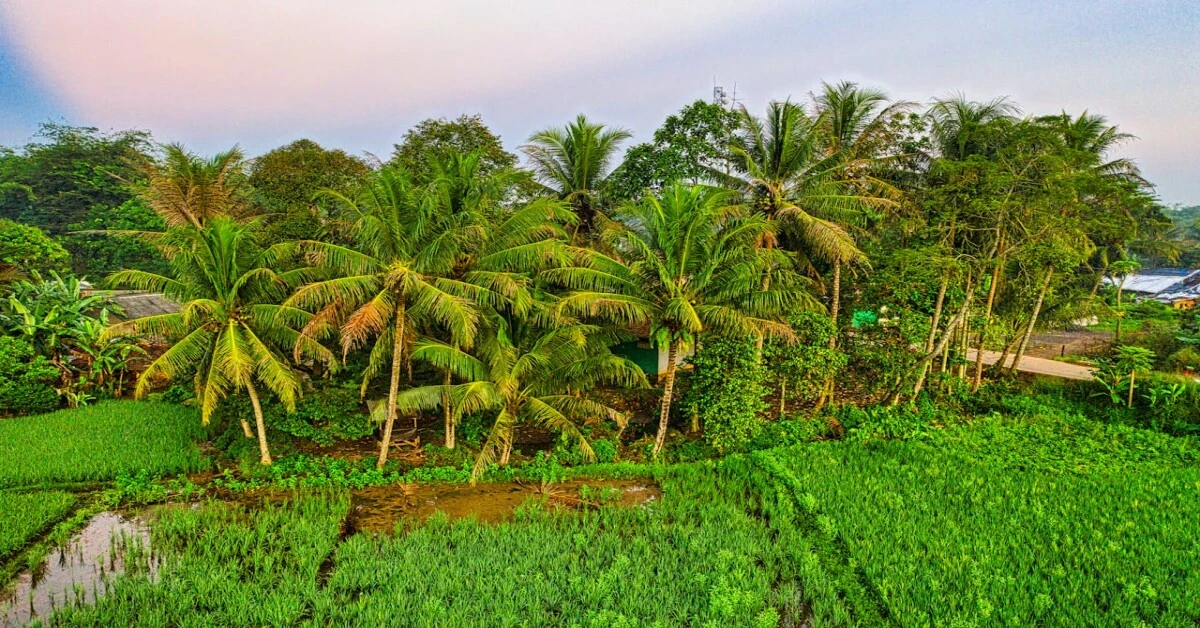Agroforestry concepts and benefits play a crucial role in sustainable agriculture worldwide. This method blends trees, crops, and livestock on the same land, creating a balanced system that supports nature and farming.
Unlike traditional agriculture, which often depletes soil and harms biodiversity, agroforestry improves land productivity while protecting the environment. Many farmers use this approach to grow food, restore forests, and combat climate change.
Agroforestry is not a new idea. For centuries, communities have planted trees alongside crops to enrich the soil and provide shade. Today, modern agroforestry practices help solve global challenges like deforestation, soil erosion, and food insecurity.
By integrating different plants and animals, farmers create healthier ecosystems and more resilient farms.
This post explores agroforestry concepts, benefits, and practical methods. You will learn how this system works, its advantages, and real-world examples from different regions.
Meaning of Agroforestry
What is agroforestry? It is a sustainable land management approach that combines trees, crops, and livestock on the same land. Agroforestry supports biodiversity, improves soil health, and enhances productivity.
Unlike traditional farming, which often depletes natural resources, agroforestry promotes long-term environmental and economic benefits. Similarly, it differs from forestry because it includes food production while maintaining tree cover.
Basic agroforestry concepts focus on creating a balanced ecosystem. Farmers plant trees alongside staple crops like maize or rice, offering shade, improving soil nutrients, and preventing erosion.
For example, in many tropical regions, coffee and cocoa grow well under taller trees, mimicking their natural habitat. This method reduces the need for chemical fertilizers and provides additional income sources through timber, fruits, or fodder.
By integrating trees with farming, agroforestry creates a resilient agricultural system. It helps farmers adapt to climate change, conserve water, and reduce greenhouse gas emissions. As a result, agroforestry is gaining recognition as a powerful solution for sustainable agriculture worldwide.

Key Objectives of Agroforestry
Agroforestry aims to create a balance between agriculture and nature. It provides social, economic, and environmental benefits. The key objectives of agroforestry include:
Enhancing Soil Fertility
Trees in agroforestry systems improve soil quality by adding organic matter and nitrogen. For example, leguminous trees fix nitrogen in the soil, reducing the need for chemical fertilizers.
Preventing Deforestation
Agroforestry encourages tree planting while maintaining productive farmland. This reduces the pressure on natural forests and helps in carbon sequestration, mitigating climate change.
Increasing Biodiversity
Unlike monoculture farming, agroforestry supports diverse plant and animal species. Birds, insects, and soil organisms thrive in these systems, creating healthier ecosystems.
Supporting Sustainable Livelihoods
Agroforestry provides multiple income sources. Farmers can harvest fruits, timber, fodder, and medicinal plants, reducing economic risks associated with single-crop farming.
These objectives make agroforestry a vital tool for sustainable land use. By promoting biodiversity and enhancing productivity, it benefits both farmers and the environment.
Also Read: Vital Components in Organic Farming Systems
Agroforestry Concepts and Components
Understanding agroforestry concepts and benefits helps in developing resilient ecosystems. This system integrates trees, crops, and livestock in ways that improve land sustainability. Three core agroforestry concepts include:
Multipurpose Tree Planting – Trees provide shade, wind protection, food, and timber. Fast-growing trees like acacia and moringa enrich the soil and offer valuable products.
Agroecological Integration – This approach combines farming with ecological principles, ensuring minimal harm to the environment. It reduces soil degradation and water loss.
Sustainable Land-Use Systems – Agroforestry supports long-term productivity by improving soil health, water retention, and biodiversity.
The three main components of agroforestry are:
Trees – These provide shade, prevent erosion, and improve soil fertility.
Crops – Staple crops like maize, coffee, and cocoa grow well alongside trees.
Livestock – Animals benefit from tree fodder and provide manure, improving soil health.
By integrating these elements, agroforestry systems create self-sustaining farms that benefit both nature and agriculture.
Common Agroforestry Practices
Agroforestry methods and benefits vary based on climate and land type. However, some practices are widely used across the world.
Alley Cropping
Alley cropping involves planting rows of trees with crops grown in between. The trees act as wind barriers, prevent soil erosion, and improve water retention.
For example, maize or wheat can be grown between nitrogen-fixing trees like Leucaena. This method increases soil fertility and provides additional income from timber or fruit trees.
Silvopasture
Silvopasture integrates trees with livestock grazing. Animals benefit from shade and improved forage, while tree roots reduce soil compaction.
This system is common in temperate and tropical regions where cattle, sheep, or goats graze under trees. It enhances land productivity while maintaining ecosystem balance. Forest Farming
Forest farming involves cultivating shade-tolerant crops under a tree canopy. Crops like mushrooms, medicinal plants, and spices thrive in these conditions. This practice is useful in maintaining forest cover while generating income from high-value crops.
Windbreaks and Shelterbelts
Windbreaks are rows of trees planted to reduce wind damage to crops. Shelterbelts serve a similar function by preventing soil erosion and protecting livestock. Farmers plant fast-growing trees like poplars or pines along field edges to create these protective barriers.
Each of these agroforestry methods supports sustainable farming. By improving biodiversity and reducing environmental impact, they offer practical solutions for modern agriculture.
5 Ways Agroforestry Benefits Farmers and the Environment
Agroforestry offers a range of advantages for both people and the planet. It strengthens ecosystems while improving farm productivity. Here are five key benefits:
Carbon Sequestration and Climate Protection
Trees absorb carbon dioxide, helping to reduce greenhouse gases. This makes agroforestry a powerful tool in fighting climate change.
Biodiversity Conservation
Agroforestry systems support diverse plant and animal life. They provide shelter, food, and nesting spaces for birds, insects, and mammals.
Higher Farm Profits
Farmers earn from multiple sources, including crops, timber, and livestock. This diversification protects them from financial losses due to market changes or weather conditions.
Lower Farming Costs
Trees improve soil fertility, reducing the need for chemical fertilizers. Their roots prevent erosion and conserve water, cutting irrigation expenses.
Better Food Security and Jobs
Agroforestry creates more employment opportunities in tree planting, harvesting, and product processing. It also boosts food production by providing fruits, nuts, and fodder for livestock.
The agroforestry benefits show how it supports both farmers and ecosystems. By promoting greener practices, it ensures a stable and profitable future for agriculture.
Agroforestry Examples in Africa and Asia
Agroforestry is practiced worldwide, adapting to different climates and landscapes. Here are three examples:
West Africa – Cocoa Agroforestry
Farmers in Ghana and Ivory Coast grow cocoa under shade trees. This protects crops from extreme heat and maintains soil moisture. It also boosts yields while preserving forest cover.
Europe – Alley Cropping
In countries like France and Germany, farmers plant trees between rows of crops such as wheat or corn. This method improves soil health, reduces wind damage, and increases productivity.
India – Agroforestry for Desert Reclamation
In Rajasthan, agroforestry is used to restore degraded lands. Farmers grow drought-resistant trees like Prosopis alongside millet and legumes. This improves soil fertility and provides fuelwood.
These examples show how agroforestry adapts to different needs while improving sustainability.
Challenges of Implementing Agroforestry
Despite its benefits, agroforestry has some challenges that slow its adoption.
High Initial Costs
Farmers need money to plant trees and maintain them. Since trees take years to grow, the returns are not immediate.
Long Growth Period
Unlike seasonal crops, trees take several years to mature. Many farmers prefer quick-growing plants for faster income.
Lack of Technical Knowledge
Many farmers do not know the best tree-crop combinations or how to manage agroforestry systems.
Possible Solutions
Governments and organizations can help by providing financial support and training programs. Agroforestry cooperatives can also share resources and expertise, making it easier for farmers to transition.
3 Ways Agroforestry Supports Global Sustainability Goals
Agroforestry plays a vital role in sustainable development. Here’s how it aligns with global goals:
UN Sustainable Development Goals (SDGs)
Agroforestry contributes to SDG 2 (Zero Hunger) by increasing food security and SDG 15 (Life on Land) by promoting reforestation.
Climate Change Adaptation and Mitigation
Trees capture carbon, reduce soil erosion, and improve water retention. This helps communities adapt to climate shifts.
International Agroforestry Initiatives
Programs like the African Forest Landscape Restoration Initiative (AFR100) and the UN-FAO’s Agroforestry Guidelines support global sustainability efforts.
Agroforestry’s role in global sustainability is clear—it helps create a resilient future for people and the planet.
Conclusion
Agroforestry combines trees, crops, and livestock to create a sustainable farming system. It enhances biodiversity, reduces environmental harm, and increases farm income.
Farmers benefit from improved soil health, lower input costs, and diversified revenue streams. Despite some challenges, government support and training can encourage its adoption.
Understanding agroforestry concepts and benefits can help create a greener future. By promoting sustainable practices, we can protect nature while ensuring food security for future generations.












